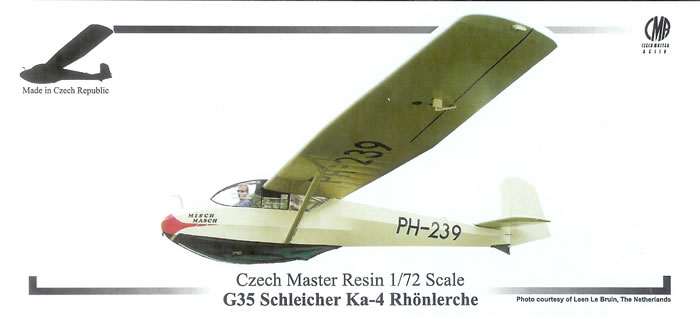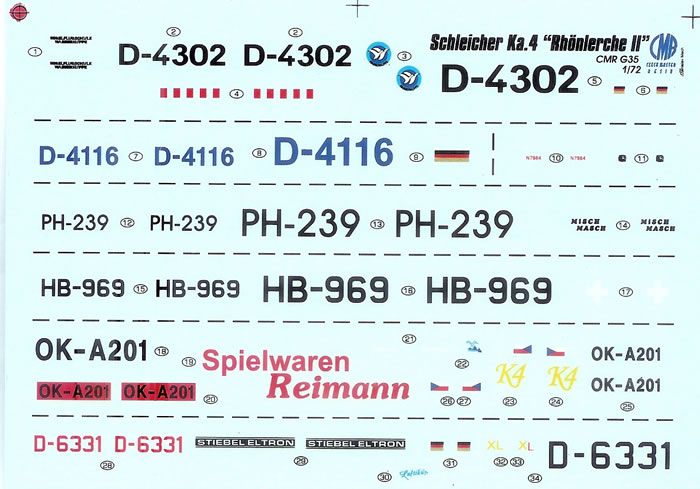|
Schleicher Ka-4 Rhonlerche

Czech Master Resin, 1/72 scale
S u m m a r y : |
Catalogue Number: |
Czech Master Resin Kit No. G35 - Schleicher Ka-4 Rhonlerche |
Scale: |
1/72 |
Contents & Media |
17 x cream resin, 2 x clear resin canopies, 1 x pre-coloured Eduard PE fret of 28 parts, 1 x Eduard pre-cut canopy mask, decals for 7 aircraft |
Price: |
Available on-line from Hannants as a Future Release, and also available from these CMR distributors |
Review Type: |
First Look |
Advantages: |
Generally simple to build with comprehensive detail and finishing information. |
Disadvantages: |
None. |
Conclusions: |
Great multi-media kit. Some skills with small PE and resin parts also needed. |
Reviewed
by Mark Davies

HyperScale is proudly supported by Squadron.com
I struggled to find much information about this glider, and was going to leave my background on the type as follows:
Alexander Schleicher GmbH & Co is a major German manufacturer of gliders, and is apparently the oldest glider manufacturer in the world. The Rhonlerche (Rhoen-lark) is a small tandem-seat trainer which first flew in 1955. It features a steel-tube, fabric-covered fuselage, a wooden fabric-covered wing with top-surface spoilers, a fixed wheel and nose skid, and tandem seating.
Then after re-defining my Google searches and browsing for quite a while I stumbled across a quote from the English translation of the book “Rhon-Adler - 75 years - Alexander Schleicher Sailplane Company” by Peter F. Selinger:
"The development and construction of the "Rhonlerche II" ("Rhoen-Lark") two-seater, which was intended for beginner training, occurred during a difficult time for Rudolf Kaiser. At that time he commuted between Dachau (Scheibe), Poppenhausen (Schleicher) and his home- town in Waldsachsen near Coburg. ... the "Rhonlerche II" was intended to be the workhorse for initial glider training. The desired characteristics for such a glider are a robust structure and good-natured and pleasant flight behaviour. Good flight performance is a secondary concern. Soon the "Rhonlerche II" acquired the nickname "Rhonstein" ("Rhoen-Rock") because of the poor glide ratio compared with other sailplanes. While the type is now mostly replaced by composite two-seaters, the "Rhonlerche II" remains very popular with vintage glider buffs. In 1963 Schleicher terminated the production of the "Rhonlerche II" after 338 of them had been built. This number includes sailplanes built under license or in a club. In 1983 there were 147 "Rhonlerche II" flying in Germany while on January 31st, 2002 only 28 remained."
So now I for one am a little wiser concerning the Rhonlerche!
CMR must be the leading producer of glider kits in 1/72 scale with over 30 military and civilian glider kits currently listed on their website. This latest kit makes a nice addition to the range of sporting gliders already covered.
The kit is packaged in a sturdy top-opening box, and all parts are in heat sealed plastic bags. Very clear assembly diagrams are accompanied by A-4 pages featuring a walk-around, along with photos of subjects covered by the decals. The walk-around has particularly good cockpit shots. The painting and decaling diagrams are comprehensive in their coverage, although all colour call-outs are generic. The instructions are in English.
This kit is a true multi-media effort In keeping with CMR’s recent releases, with pre-coloured photo-etch fret and a pre-cut canopy mask made by Eduard. The PE enables a very high level of detail to be achieved inside the cockpit where the pre-coloured instrument panels and seatbelts should be stand out features. There is a choice of PE instrument panels as one of the decal options offered by the kit has a different style of panel to the other six. Remaining uncoloured PE parts cover some ground-handling holds, aileron actuators, and pitot. (This last item will need to be thickened with something like Mr surfacer, or used as a pattern for fine wire or similar.)
The kit is in fact very small and quite delicate, like many 1/72 sports gliders. The resin parts are very crisply moulded, with very fine trailing edges. Some parts have minor flash that can be cleaned up in seconds, although care will be needed with some of the very delicate items like the rudder pedals. I could not see any pinholes. At first the airframe assembly looks to be simplicity itself, as very few parts are involved. However the wing is in two parts and is a butt-fit to the clear canopy. Ultimately struts support the wings so no additional strengthening is needed, but care with super-glue will be necessary at the canopy join. A bit of constructional jugging should help here.
The Rhonlerche has a distinctive canopy consisting of a very delicate framework supporting mainly flat perspex side panels, and top panels curved in only one plane. CMR has chosen to represent this using clear resin. Looking at the way the wings must fit to the fuselage this is no doubt due structural considerations, which I think preclude CMR’s more usual use of vac-from acetate (at least for the rear canopy where the wings mount).
The clear resin will be quite acceptable after a gentle polish and a dip in Future. I would have liked the option of a vac-form clear part to cater for the upward folding front canopy because it would better capture the delicate and rather flimsy nature of the real item. However this is a small point, and irrelevant if the canopy is left closed. The good news is the Eduard pre-cut canopy mask to take care of some tricky framing.

The seven decal options cover two German, American, Dutch, Swiss and Czech civilian schemes The decals have good registration and colour density. They should go on very well from my own experience of CMR decals. Be aware however that they are quite thin, and must be floated into position as they can be hard to budge once positioned and tamped down.
Overall this is a excellent multi-media kit of a 1950’s glider, albeit one with modest performance and looks. Some care will be needed with the detail parts. I recommend this kit to fans of sports gliders or anyone wishing to build something a bit different.
Thanks to Czech Master Resin for this review sample.
CMR Models are available
online from Hannants in the UK,
Red Roo Models in Australia
and
quality specialist model retailers worldwide.
Text Copyright © 2009 by Mark Davies
This Page Created on 18 October, 2009
Last updated
21 October, 2009
Back to HyperScale
Main Page
Back to Reviews
Page
 |
